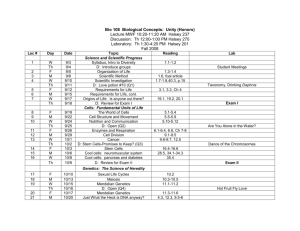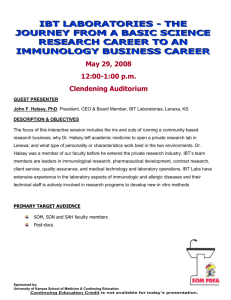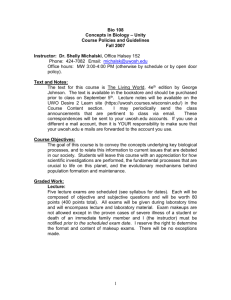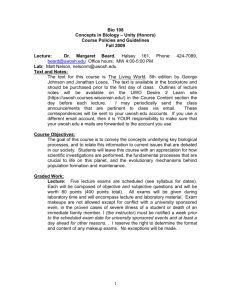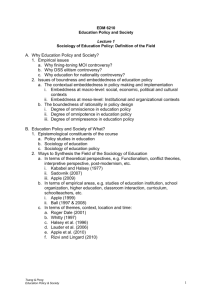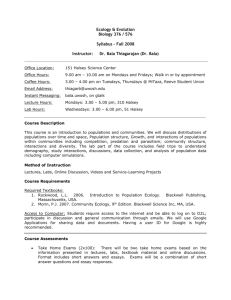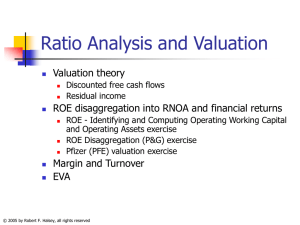Fleet Admiral William F. 'Bull' Halsey
advertisement
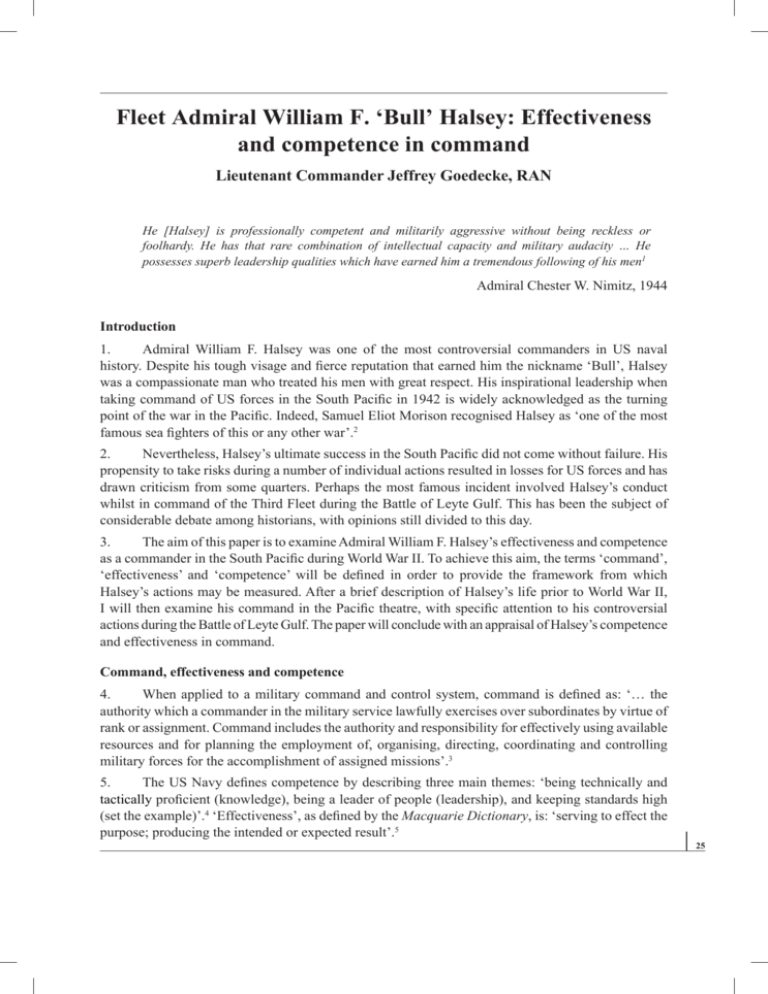
Fleet Admiral William F. ‘Bull’ Halsey: Effectiveness and competence in command Lieutenant Commander Jeffrey Goedecke, RAN He [Halsey] is professionally competent and militarily aggressive without being reckless or foolhardy. He has that rare combination of intellectual capacity and military audacity … He possesses superb leadership qualities which have earned him a tremendous following of his men1 Admiral Chester W. Nimitz, 1944 Introduction 1. Admiral William F. Halsey was one of the most controversial commanders in US naval history. Despite his tough visage and fierce reputation that earned him the nickname ‘Bull’, Halsey was a compassionate man who treated his men with great respect. His inspirational leadership when taking command of US forces in the South Pacific in 1942 is widely acknowledged as the turning point of the war in the Pacific. Indeed, Samuel Eliot Morison recognised Halsey as ‘one of the most famous sea fighters of this or any other war’.2 2. Nevertheless, Halsey’s ultimate success in the South Pacific did not come without failure. His propensity to take risks during a number of individual actions resulted in losses for US forces and has drawn criticism from some quarters. Perhaps the most famous incident involved Halsey’s conduct whilst in command of the Third Fleet during the Battle of Leyte Gulf. This has been the subject of considerable debate among historians, with opinions still divided to this day. 3. The aim of this paper is to examine Admiral William F. Halsey’s effectiveness and competence as a commander in the South Pacific during World War II. To achieve this aim, the terms ‘command’, ‘effectiveness’ and ‘competence’ will be defined in order to provide the framework from which Halsey’s actions may be measured. After a brief description of Halsey’s life prior to World War II, I will then examine his command in the Pacific theatre, with specific attention to his controversial actions during the Battle of Leyte Gulf. The paper will conclude with an appraisal of Halsey’s competence and effectiveness in command. Command, effectiveness and competence 4. When applied to a military command and control system, command is defined as: ‘… the authority which a commander in the military service lawfully exercises over subordinates by virtue of rank or assignment. Command includes the authority and responsibility for effectively using available resources and for planning the employment of, organising, directing, coordinating and controlling military forces for the accomplishment of assigned missions’.3 5. The US Navy defines competence by describing three main themes: ‘being technically and tactically proficient (knowledge), being a leader of people (leadership), and keeping standards high (set the example)’.4 ‘Effectiveness’, as defined by the Macquarie Dictionary, is: ‘serving to effect the purpose; producing the intended or expected result’.5 25 GEDDES PAPERS 2004 6. This paper will therefore measure Halsey’s performance in command by determining whether his leadership, technical proficiency and ability to organise, direct, coordinate and control available resources produced the intended results. William F. Halsey 7. Firstly, it is important to look at Halsey’s early years to determine the influences and experiences that shaped his character and leadership style. William Fredrick Halsey Jr. was born 30 October 1882, in Elizabeth, New Jersey. He seemed destined for a naval career, as his father was a captain in the US Navy and an ancestor, Captain John Halsey, was a commissioned privateer who turned buccaneer. In 1900, after gaining one of five presidential appointments for the year, William F. Halsey Jr. entered the US naval academy. He was not particularly studious, tending to prefer social interaction and football to his studies, however he passed all of his examinations and graduated 43 of 62 in his class. 8. Soon after the US entered Word War I, Halsey joined the US Destroyer force based at Queenstown, Ireland. He spent much of the war in command of destroyers, conducting anti-submarine patrol and escort duties in the Atlantic, where he gained a reputation as an intuitive leader who acted on his instincts. Halsey once commented ‘… since the man on the spot had so much better information than the man at headquarters, it was impossible for headquarters to give proper instructions’.6 This proved to be a harbinger for his actions in command during the Second World War, when he had overall command of the South Pacific theatre. As will be seen later, his ‘on the spot’ decision during the Battle for Leyte Gulf proved to be a controversial one. Halsey was awarded the Navy Cross for his anti-submarine patrol actions during the First World War. 9. After the war, Halsey took command of a squadron of destroyers operating in both the Atlantic and the Pacific, then was offered command of an aircraft carrier, with the proviso that he first train and qualify as an aviator. At the age of 52 he earned his pilot’s wings and took command of the carrier SARATOGA. In 1937 he transferred to the naval station at Pensacola, Florida, as Commandant and was promoted to Rear Admiral, before returning to sea in command of a carrier division. In the spring of 1940, he was designated Commander Aircraft Battle Force with the rank of Vice Admiral, effectively commanding all the carriers in the Pacific Fleet and their air groups. Command in World War II 10. When the Japanese attacked Pearl Harbor in December 1941, Halsey was at sea aboard the carrier ENTERPRISE, 150 miles from base. Upon return, he was deeply affected by the visible carnage the Japanese had inflicted at Pearl Harbor and was heard to snarl, ‘before we’re through with ‘em, the Japanese language will be spoken only in hell!’7 This was one of Halsey’s many declarations of hatred against the Japanese and vows of retribution, which were popular with his subordinates, the press and ultimately the American public. ‘Halsey emerged as the most outspoken foe of the Emperor’s minions after Pearl Harbor. Halsey was implacable. He hated. And that is what made him such a formidable adversary.’8 11. In February 1942, whilst in command of a carrier group, Halsey’s warplanes attacked Kwajalein, Roi and Jaluit and his cruisers bombarded Wotje atoll, often with his ship within sight of enemy-held territory. Potter contends that ‘Halsey was thus exposing his ships to appalling risks.’9 Nonetheless, Halsey’s willingness to take risks, coupled with his effective use of the forces under his command, achieved decisive results. These attacks, the first time American forces assaulted the 26 FLEET ADMIRAL WILLIAM F. ‘BULL’ HALSEY: EFFECTIVENESS AND COMPETENCE IN COMMAND Japanese defences in the Pacific, resulted in acclaim for Halsey as a hero back home. ‘His name and reputation as first American victor over the Japanese had resounded throughout the navy and around the world. In every sailorman’s book he was down as the “fighting admiral” who had first smacked the enemy.’10 12. Around this time, Halsey developed health problems with serious dermatitis that necessitated his return to the US for hospitalisation. He displayed superb judgement in appointing Admiral Spruance in his stead to lead US forces in the Battle of Midway. However Halsey was extremely disappointed to have missed participation in this battle. In an address to the Naval Academy he remarked: ‘Missing the Battle of Midway has been the greatest disappointment of my life, but I am going back to the Pacific where I intend personally to have a crack at those yellow-bellied sons of bitches and their carriers.’11 During the months Halsey was incapacitated, the war in the Pacific swung in favour of the Japanese. 13. In October 1942, Admiral Nimitz (CinCPac)12 decided to replace Admiral Ghormley as Commander South Pacific as he believed he was ‘too immersed in detail and not sufficiently bold and aggressive at the right times’.13 Word of Halsey’s succession to the [South Pacific] Command was received on ships and stations with wild enthusiasm. An officer on Guadalcanal recalled the effect on the men there: ‘I’ll never forget it: One minute we were too limp with malaria to crawl out of our foxholes; the next, we were running around whooping like kids’.14 14. To effectively turn around the situation in the Pacific, Halsey once again employed audacious action in the latter months of 1942, for which he was later criticised. In the Battle for Santa Cruz, for example, Halsey committed an inferior force against the entire Japanese Combined Fleet, which resulted in the sinking of an American carrier and destroyer with damage to other US ships. Tactically, Halsey’s force lost the sea battle of the Santa Cruz Islands, however his ‘gamble’ had strategic benefit for the Americans as twice as many Japanese aircraft were destroyed compared to those of US forces. Similar risks were taken during the Battle for Guadalcanal, where he again pit his units against superior forces and took heavy losses, which included the sinking of the carrier HORNET. While it may be argued these losses could have been avoided by adopting less aggressive tactics, ultimately this prevented the Japanese from ever attempting to subsequently resupply or reinforce there. These naval surface actions and air attacks under Halsey’s firm leadership and direction, whilst risky and resulting in American losses, turned the previous defensive posture in the South Pacific into an offensive one and restored morale to US forces in the Pacific. 15. By 1944, the command structure in the South Pacific theatre had become over complicated. Effectively, one half of the American Pacific Forces were under the command of Admiral Nimitz who was ashore at Pearl Harbor, with Halsey at sea as his subordinate Third Fleet commander. The other half of the Pacific forces were under General MacArthur with his Seventh Fleet Commander, Admiral Kinkaid, as his subordinate. In effect there existed two autonomous tactical fleet commands supporting the same operation. This absence of a unified command in the Pacific would ultimately beleaguer the entire Leyte campaign. Leyte Gulf 16. On 12 and 13 September 1944, Halsey’s forces flew 2,400 sorties off the central Philippines, destroying 200 Japanese planes, many installations and numerous ships, with a cost of only eight US planes. Following additional reports from Filipinos that there were no Japanese on Leyte, Halsey formed a daring strategy. His subsequent recommendation resulted in planned operations to land in the Philippines at Letye being brought forward from December to October 1944. 27 GEDDES PAPERS 2004 17. The Leyte Gulf Plan, signed by Nimitz on September 27, directed forces of the Pacific Ocean areas to ‘cover and support forces of the SWPAC’.15 However it also ordered the Third Fleet, that is, Admiral Halsey, to ‘destroy enemy naval and air forces in or threatening the Philippine Area.’ A separate directive to Halsey went even further: ‘in case opportunity for destruction of a major portion of the enemy fleet offers or can be created, such destruction becomes the primary task’.16 This left Halsey with ambiguous orders that were ostensibly open to interpretation. 18. On October 20, more than 60,000 American troops were landed at Leyte, virtually unopposed. This was a significant blow to the Japanese who realised they could ill-afford to allow US forces to consolidate their position. Consequently, Admiral Soemu Toyoda at Japanese naval headquarters ordered the Combined Fleet to carry out the plan they labelled ‘Sho-1’.17 19. On 24 October, Halsey used air strikes to concentrate on the large Japanese Centre Force, compelling Kurita to withdraw into the Sibuyan Sea. With reports of the Centre Force’s withdrawal and a contact report of the Northern Force, Halsey needed no further encouragement. He believed he now had the major carrier group located to the north and that Kinkaid’s Seventh Fleet units could easily account for approaching Japanese forces. Halsey took his 64 ships northwards, abandoning San Bernardino Strait, bent on a battle that would surely see the destruction of the Japanese Fleet. Meanwhile, Admiral Kinkaid believed erroneously, that Halsey had formed and left behind elements of his force (a Task force 34) to guard the San Bernardino Strait.18 20. By the time Halsey was in aircraft range of Ozawa’s Northern Force, Kurita had exited the San Bernardino Strait and was engaging Kinkaid’s Seventh Fleet. Kinkaid believed he was in trouble and was signalling higher command to determine the location of Halsey’s Task Force 34. At Pearl Harbor, Nimitz grew concerned about the developing situation. He sent a message to Halsey: ‘where is, repeat, where is Task Force 34?’ It was customary for the encoder to add an irrelevant phrase to the front and back of the message to confuse Japanese decoders. Unfortunately, the end phrase was ‘all the world wonders’ and was not removed from the message when handed to Halsey. 21. Halsey was furious at this message, believing his Commander-in-Chief had taken to deriding his decisions and actions from thousands of miles away. Consequently, whilst only 42 miles from Ozawa’s force, but feeling he had no alternative, Halsey formed and detached Task Force 34 to proceed southwards, convinced he was about to miss one of the greatest of naval victories. ‘I turned my back on the opportunity I had dreamed of since my days as a cadet’, he said afterwards, ‘for me, one of the biggest battles of the war was off, and … “the Battle of Bull’s Run” was on.’19 In ‘Iron Admirals’, Andidora criticised Halsey for underestimating the strength of the Centre Force and for losing his temper as a result of the Nimitz dispatch, which ultimately did nothing to assist the Seventh Fleet, and effectively denied the Third Fleet an opportunity to decimate Ozawa’s Northern force.20 22. Fortunately for American forces, Kurita overestimated the opposition he faced when emerging from the San Bernardino Strait, and withdrew prematurely. Had he pressed on his attack, the outcome may have been quite different. It may be argued that Halsey’s actions in leaving the Strait unguarded cost Kinkaid’s forces an escort carrier, two destroyers, and a destroyer escort, and permitted the bulk of Kurita’s Centre Force to escape. Nevertheless, the bulk of Halsey’s Third Fleet (without Halsey himself) seriously damaged the Japanese Northern Force and effectively ended Japan’s naval offensive capability in World War II. 28 FLEET ADMIRAL WILLIAM F. ‘BULL’ HALSEY: EFFECTIVENESS AND COMPETENCE IN COMMAND Competence and effectiveness in command 23. There is no doubt that Halsey exercised command. Immediately following the attack on Pearl Harbor, Halsey was appointed in command of all vessels to search for the attacking Japanese force. It was Halsey who was endeared to all Americans as the man who struck a decisive blow against the Japanese in retaliation for Pearl Harbor, and when the war in the Pacific looked to be favouring the Japanese, he was selected as Commander of the South Pacific forces. Halsey was clearly respected by his superiors and also enjoyed considerable popularity and loyalty from his subordinates. ‘Admiral Halsey’s strongest point’, wrote a staff officer, ‘was his superb leadership. While always the true professional and exacting professional performance from all subordinates, he had a charismatic effect on them, which was like being touched by a magic wand. Anyone so touched was determined to excel.’21 24. Among Halsey’s most significant credits was his strategic insight to bring about the early invasion of Leyte, which effectively shortened World War II. It must also be argued that under Halsey’s command, responsibility fell for the losses of American ships HORNET, CHICAGO, PRINCETON and GAMBIER BAY. The most controversial of Halsey’s actions, the decision to leave San Bernardino Strait unguarded, is still widely debated. It may be argued that Halsey’s judgement may have been clouded, that he had been spoiling for a fight, particularly having missed the Battles of Midway and the Coral Sea, and thus saw an opportunity for a massive victory at sea over the Japanese. Morison writes, ‘Admiral Halsey’s erroneous estimate … was the primary event in a chain of wrong assumptions’.22 Halsey also drew criticism from Professor Clark Reynolds in his book, The Fast Carriers, where he questioned Halsey’s intelligence, suggesting he could have divided his forces to allow San Bernadino Strait to be guarded, but that ‘such tactics were simply too complex for Bull Halsey’.23 25. Conversely, closer analysis of the events indicate many factors that may otherwise support Halsey’s decision. Clearly Nimitz’ orders for Halsey were not as articulate as they should have been. Poor communications, ambiguous reporting and complicated higher command and control structure all contributed to the ‘fog of war’. Cohen and Gooch refer to this kind of misfortune as ‘the ghost in the machine’.24 They profess that errors of this type are not the responsibility of any one person, not even the military commander. Rather, ‘the ghost in the machine’ to which they refer is a factor of the inherent fragility of an entire organisation. However, probably the most important of factors is that a commander can only realistically act on the information available to him at the time of a decision. At Leyte Gulf, Halsey had no way of knowing that Ozawa’s carrier force was poorly armed and was in fact a decoy. Halsey also correctly observed naval doctrine of the time that stressed concentration of force, and a headquarters analysis received only one month prior to Leyte Gulf action warned against the practice of dividing a carrier force. As the man ‘on the spot’, he therefore had little alternative to those actions he embarked upon given the information he had at the time. Andidora supports this viewpoint: ‘Halsey would have been foolish to divide his ten available carriers while still unaware that Ozawa’s carriers were relatively toothless. His decision … not only conformed to the principle of concentration but was correct in the surrounding circumstances.’25 Thus, while the Battle for Leyte Gulf may be a case of military failure in some respects, it was a combination of individual factors that led to the outcome. 26. Much of the criticism of Halsey’s competence and effectiveness in command is focused on individual actions. This subjective view is not representative of the enormous scope of his responsibility in command of the South Pacific forces. Risks were taken and certain losses endured, 29 GEDDES PAPERS 2004 as they contributed to the bigger picture with overall victory as the goal. Halsey’s extensive technical knowledge of carrier air power in particular, enabled him to deploy and employ his units to achieve decisive results. As a theatre commander, he acted boldly on the information available to him, arguably turning the war in favour of the Americans and ultimately achieving early defeat of the Japanese in the Pacific. History therefore shows that as Commander of the South Pacific forces in World War II, he was not only competent, but also extremely effective. Conclusion 27. This paper has examined Halsey’s effectiveness and competence in command in the Pacific during World War II and focused on some of the controversial decisions he made, particularly at Leyte Gulf. It has been shown that subjective analysis of individual actions may not be the best measure to determine ultimate effectiveness and competence of a commander. The war in the Pacific necessitated unique use of resources, particularly employment of aircraft carriers, in operations where high risk promised high gain. Halsey’s strategic insight and decisive actions may have been controversial at times, but ultimately influenced the achievement of early victory in the Pacific against the Japanese. 28. Halsey’s colourful language, inspirational leadership and single-minded determination to annihilate the Japanese threat saw him revered by his men and adored by the American public. His fervent determination was evident even after victory over the Japanese was well within grasp of the Allied forces: ‘My only regret is that our ships don’t have wheels, so that when we drive the Japs from the coast we can chase them inland’.26 Regardless of how individual decisions have been dissected by historians and critics, ‘Bull’ Halsey remains one of the greatest leaders in American military history, who was instrumental in the defeat of the Japanese in the South Pacific, and was both effective and competent in command. 30 FLEET ADMIRAL WILLIAM F. ‘BULL’ HALSEY: EFFECTIVENESS AND COMPETENCE IN COMMAND Endnotes 1. E.B. Potter, 1976, NIMITZ, Naval Institute Press, Anapolis, p. 208. 2. Samuel Eliot Morison, 1958, History of United States Naval Operations in World War II–Volume XII ‘Leyte’, Little, Brown and Co., Boston. 3. Commonwealth of Australia (Australian Army) 2003, Land Warfare Doctrine 0–0, Command, Leadership and Management, pp. 2–3. 4. Karel Montor, et al., 1987, Naval Leadership—Voices of Experience, US Naval Institute, p. 484. 5. The Macquarie Concise Dictionary, 1988, 2nd edn, The Macquarie Library, Sydney, p. 558. 6. James Bassett, Warlords: Military Commanders of the Twentieth Century, Weidenfeld & Nicolson, Boston, p. 433. 7. William F. Halsey, 1947, Admiral Halsey’s Story, Whittlesea House, London, p. 81. 8. Bassett, op. cit., p. 435. 9. E.B. Potter, 1985, Bull Halsey, Naval Institute Press, Anapolis, p. 47. 10. ibid., p. 155. 11. Potter, Bull Halsey, op. cit., p. 150. 12. Commander-in-Chief, Pacific forces. 13. Potter, Nimitz, op. cit., p. 197. 14. ibid., p. 160. 15. The SWPAC forces referred to were Admiral Kinkaid’s Seventh Fleet, under MacArthur’s command, protecting the landing forces at Leyte. 16. Potter, Bull Halsey, op. cit., p. 279. 17. This plan was a three–pronged naval attack against US forces at Leyte. A Northern force under Admiral Ozawa was to act as a decoy to lure Halsey’s Third Fleet away from the beachhead at Leyte. A Centre Force, under Admiral Kurita, comprising a powerful group of 36 ships including the world’s two most powerful super-battleships, were to steam through the San Bernardino Strait and strike Leyte Gulf. To complete the ‘pincer’ movement, a Southern force under Admiral Nishimura was to manoeuvre through the Surigao Strait to the south of Leyte in an attempt to destroy the US fire support ships at Leyte Gulf. 18. Kinkaid routinely monitored Halsey’s communications as the two commanders had no direct liaison authority. He misinterpreted Third Fleet intra-fleet signals that referred to a Task Force 34 that had not actually been formed. 19. Potter, Bull Halsey, op. cit., p. 304. 20. Ronald Andidora 2000, Iron Admirals—Naval leadership in the Twentieth Century, Greenwood Press, Westport, Connecticut, p. 147. 21. James E. Merrill, undated, Fleet Admiral William F. ‘Bill’ Halsey, comps. Dave James, viewed 11 February 2004, <http://www.compass.dircon.co.uk/Halsey.htm>. 22. Morison, op. cit., p. 291. 23. James M. Merrill, 1976, A Sailor’s Admiral: A Biography of Admiral William F. Halsey, Crowell, New York, p. 176. 24. Eliot A. Cohen and John Gooch, 1990, Military Misfortunes: the Anatomy of Failure in War, The Free Press, New York, p. 243. 25. Andidora, op. cit., p. 145. 26. Hough, op. cit., p. 260. 31 GEDDES PAPERS 2004 Bibliography Andidora, Ronald, 2000, Iron Admirals—Naval leadership in the Twentieth Century, Greenwood Press, Westport, Connecticut. Bassett, James, 1976, Admiral William F. Halsey, Carver, Michael Sir (Ed.), Warlords: Military Commanders of the Twentieth Century, Weidenfeld & Nicolson, London. Buell, Thomas B., 1980, Master of Sea Power, a Biography of Fleet Admiral Ernest J. King, Little, Brown and Co., Boston. Cohen, Eliot A. and Gooch, John, 1990, Military Misfortunes—the Anatomy of Failure in War, The Free Press A Division of Macmillan, Inc., New York, N.Y. Falk, Stanley L., 1976, in Frankland, N. and Dowling, C. (eds), Decisive Battles of the Twentieth Century, Land–Sea–Air, Sidgwick and Jackson, Great Britain. Halsey, William F., 1947, Admiral Halsey’s Story, Whittlesey House, USA. Hough, Richard, 1977, The Great Admirals, Weidenfeld & Nicolson, London. MacArthur, Douglas, 1964, Reminiscences, William Heinemann Ltd, London. Merrill, James M., 1976, A Sailor’s Admiral: A biography of William F. Halsey, Crowell, New York. Merrill, James M., 1992, ‘Fleet Admiral William F. Halsey Jr.’, in S. Howarth, (ed). Men of War—Great Naval Leaders of World War II, Weidenfeld & Nicolson, London. Merrill, James E. undated, Fleet Admiral William F. ‘Bill’ Halsey, comps. Dave James, viewed 18 February 2004, <http: //www.compass.dircon.co.uk/Halsey.htm>. Montor, Karel, et al., 1987, Naval Leadership—Voices of Experience, US Naval Institute, Maryland. Morison, Samuel Eliot, 1958, History of United States Naval Operations in World War II Vol. XII ‘Leyte’, Little, Brown and Co., Boston. Potter, E.B., 1985, Bull Halsey, US Naval Institute, Anapolis Maryland. Potter, E.B., 1976, Nimitz, Naval Institute Press, Anapolis Maryland. 32 W IS DO M IS STREN GT H
